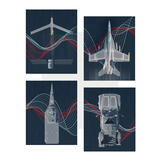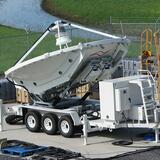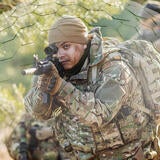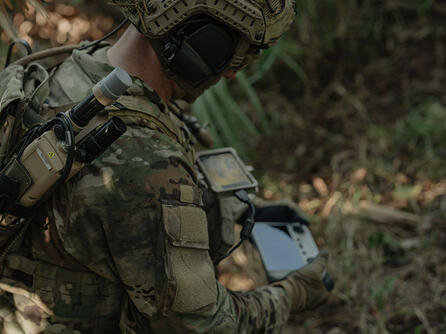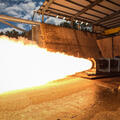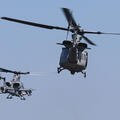The U.S. military is entering into an unprecedented era of competitive Electronic Warfare (EW) environments against peer and near-peer adversaries alike.
Threats have evolved considerably over the years since current EW systems were designed, and technology advancements have accelerated since the turn of the century.
Air-defense systems leverage more radars than ever before – each an individual threat that Airborne Electronic Attack (AEA) systems must target – overwhelming the capability of assets currently in the field. Further, since the early 2000s, there has been a shift from U.S. adversaries toward employing low-frequency tactics to take out aircraft.
“Some threats employ using lower frequency detection systems,” John Ghosh, L3Harris Technologies Business Development director, said. “They don’t get the same high-confidence solution they might out of, say, an X-band asset, but it can be good enough to employ a long-distance weapon with its own terminal guidance.”
The U.S. military requires a capable EW system today that can overmatch enemy air defense systems with the flexibility to adapt to the growing adversarial capabilities of tomorrow.
A New, Advanced Battlespace
An increase in the number of threats, as well as the power an EW asset can manage, is a paramount requirement for expeditious success in AEA missions going forward. Just as important is the safety of U.S. personnel and survivability of assets; enabling warfighters to engage more threats from farther away provides tactical advantages and flexibility.
Aerial Electronic Attack of Tomorrow
Currently, the EA-18G Growler is the U.S. Navy’s only tactical EW platform, supporting joint-force missions as well as the Navy’s. The naval service is currently evaluating proposals to replace the Growler’s current ALQ-99 Tactical Jamming System.
“The Navy has a large appetite for more-capable systems,” Ghosh said. “They recognize they have capability gaps – and they also recognize emerging threats will require them to adapt the system over time. They want a solution that can operate in the fight today but also need to quickly incorporate new technology to combat emerging air-defense systems.”
Considering the lifecycle of such a critical system and how fast technology evolves, it is imperative that the U.S. military look to new, open-systems design approaches to ensure the viability of next-generation platforms for the long term. While previously produced solutions might meet the requirements now, older systems become expensive to maintain over time and do not provide the same glide path for technology insertions or robust maintenance plans that can facilitate capabilities.
A Unique Perspective
L3Harris has been an industry leader in delivering resilient communications datalinks to global defense organization for decades.
To design robust waveforms that can stand up to jamming threats, engineers must have a solid understanding of how adversaries attempt to attack U.S. communications systems – and how they might look to in the future.
With that in mind, Electronic Warfare is a natural adjacency for one of the world’s preeminent resilient waveform producers, according to Randy Smith, L3Harris project manager of the Next Generation Jammer program.
“It’s about owning the spectrum,” Smith said, noting that many of L3Harris’ waveforms perform in low-band frequency, the same as those emerging as a threat to U.S. aircraft in current combat. “If we can figure out how to prevent people from jamming our communications, we can do the inverse and jam radars and their communications.”
L3Harris began collaborating with government labs and investing internal research and development funding into EW technology in the late 2000s, he said. The company first won several small government contracts in the field as it proved its capability, which led to producing a jamming effects simulator for the U.S. Navy.
Jam Today, Jam Tomorrow
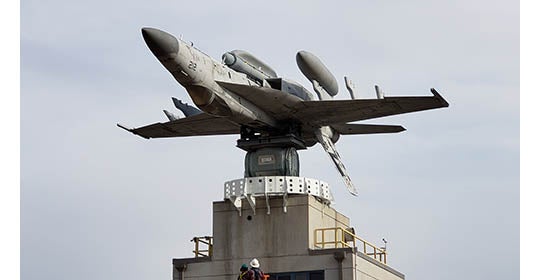
With its prowess in designing resilient communication solutions and investments made in translating those skills and honing them for EW capabilities, L3Harris is well-positioned to provide the U.S. military AEA technology that can meet the threat today and become stronger over time to continue to outmatch adversarial systems for the foreseeable future.
L3Harris’ design approaches facilitate the power required to overwhelm targets at distances that U.S. assets cannot be touched. Expertise in advanced waveforms gives the company the ability to design tailored, flexible solutions to counter distinct threats. Most importantly, L3Harris understands the evolving threat environment and drove enhancements for more targets to be engaged by a single asset than ever before.
“It’s all about being able to jam today and tomorrow at the maximum standoff distance to safeguard America’s assets and people,” Smith said. “The nation needs to be able to move quickly and go after emerging threats. That’s why we have been aggressive and spent a significant amount of time in engineering and designing systems that will move our customers forward. We continue to invest in and leverage existing capabilities to maintain that promise.”
Winning the Near-Peer Fight
L3Harris Technologies submitted a proposal this month for the U.S. Navy’s Next Generation Jammer – Low Band (NGJ-LB) competition. L3Harris won the original contract in December 2020 with an “Outstanding” technically evaluated solution that led to a protest by a competitor. The program includes prototype development and deliveries of tactical jamming pods designed to modernize the EA-18G Growler’s Electronic Warfare (EW) capability.
NGJ-LB will be a high-powered and advanced AEA system. L3Harris’ jamming pod enables extended stand-off jamming, covers a broad spectrum of frequencies to service U.S. Department of Defense-wide EW demands, and will be more sustainable than the current system. The system will operate seamlessly with joint and allied forces and can incorporate new technologies to counter emerging threats.
The Navy expects contracted work to be completed within five years. NGJ-LB will address shortfalls in capability, availability and sustainment of the Navy’s existing AN/ALQ-99 Tactical Jamming System.
L3Harris is leveraging decades of industry-leading experience in providing resilient communication datalinks and significant internal research and development investments in EW to deliver a system to meet future needs today.


